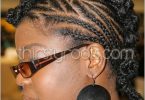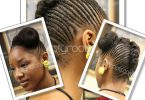Cornrows zig zag patterns are very common among African Americans today, but this is only a somewhat recent phenomenon. Ironically, these hairstyles have been around for centuries. In fact, historians have found evidence of these hairstyles dating as far back as 500 B.C. in the hieroglyphs and sculptures of temples and other buildings. It might even surprise you that on the back of the head of the Sphinx in Egypt you will see tight braids going down the back.
These hairstyles can trace their origins to Africa and Nigeria and, obviously, Egypt. So how did they come to be so popular in America in the 21st century? This is indeed an interesting story that spans almost all of modern history. Cornrows started as a means of establishing regional distinctions between tribes and people. Different tribes in different parts of Africa, Nigeria, and Egypt used hairstyling as a way to mark their families. These results may appear similar to the untrained eye, but the mesmerizing artistry is indeed very distinct. There may be an endless number of possible ways to design hair using this method.
Speaking of the method, cornrows are made with an upward, underhand motion that starts very tight to scalp. Several strands of hair are braided and then set to a particular design. These designs can be simple or complex. They can be done in a very basic and practical way or to draw on a person’s individuality.
Cornrows are indeed very practical. While it can take several hours to finish an entire set, once you are finished, you do not have to touch them for many weeks, even up to a month. You can simply wash them just like normal hair. It is also recommended that you use a bit of oil every once in a while to keep your hair and scalp from drying out. Other than that you need no other special care items of procedures.
These hairstyles became popular after the Civil Rights and Black Pride Movements because they established a new awareness for African heritage. Out of this desire, African American entrepreneurs started salons and beauty shops to give people access to skilled hair artisans. This allowed people to get their hair done in a traditional way, but with modern flare. Then, as black entertainment grew in American, these styles became even more embedded in the cultural identity and the awareness was reborn again.






